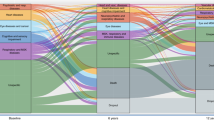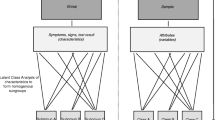Abstract
Conventional cluster analyses of patient populations are intended to assist in the identification and characterization of groups that may represent etiological or pathological subtypes within a particular disease class. These methods have been criticized as being insensitive to subtle patient differences, which may be masked as a result of the all-or-nothing concept of cluster membership intrinsic to crisp set-theoretic-based grouping algorithms. As an alternative to conventional clustering procedures, several investigators have studied the use of fuzzy classification methods. In general, these measure a patient's clinical status in terms of a real number defined on the closed unit interval, reflecting the extent or degree to which a particular grouping entity characterizes the patient. This paper compares and contrasts the applications of crisp and fuzzy settheoretic-based clustering procedures to a set of data describing the cognitive and intellectual functioning of a group of subjects participating in a longitudinal study of aging. Emphasis is placed on both qualitative and quantitative aspects corresponding, respectively, to the clinical interpretation of cluster definitions, and the robustness or sensitivity of the classification procedures to changes in patient profiles over time. The fuzzy set-theoretic-based model was found to be more sensitive to changes in subject level of functioning over time, to provide superior quantitative protrayals of patterns of aging, and to reflect properties of the aging process derived from other research.
Similar content being viewed by others
References
Weinstein, M.C., and Fineberg, H.V.,Clinical Decision Analysis, W.B. Saunders, Philadelphia; 1980.
Cormack, R.M., A review of classification.J. R. Stat. Soc. 134:321, 1971.
Miller, M.C. III, Westphal, M.C., Jr., and Reigart, J.R., III,Mathematical Models in Medical Diagnosis, Praeger, New York, 1981.
Fordon, W.A., and Bezdek, J.C., The application of fuzzy set theory to medical diagnosis.Advances in Fuzzy Set Theory and Applications (M.M. Gupta, R.K. Ragade, and R.R. Yager, eds.), Elsevier North Holland, New York, 1979, pp. 445–461.
Ledley, R.S., and Lusted, L.B., Reasoning foundations of medical diagnosis.Science 130:9, 1959.
Ledley, R.S., and Lusted, L.B., Medical diagnosis and modern decision making.Mathematical Problems in the Biological Sciences, Proceedings of Symposia in Applied Mathematics, Vol. 14, American Mathematical Society, Providence, Rhode Island, 1962, p. 117.
Woodbury, M.A. Inapplicabilities of Bayes' Theorem to Diagnosis.Proceedings of the Fifth International Conference on Medical Electronics, Liege, Belgium, 1963, pp. 860–868.
Woodbury, M.A., Clive, J., and Garson, A., Jr., Mathematical typology: A grade of membership technique for obtaining disease definition.Comp. Biomed. Res. 11:277, 1978.
Woodbury, M.A., and Clive, J., Data-based definitions of disease: Suggestions for a Solution of the formal diagnostic problem.Proceedings of the Thirteenth Annual Hawaii Conference on Systems Science, Honolulu, Hawaii, January 1980, pp. 590–600.
Clive, J., Elicitation of subjective diagnostic opinion. Doctoral dissertation, Yale University, 1973.
Feinstein, A.,Clinical Judgment, Williams and Wilkins, Baltimore, 1967.
Pellegrino, E.D., and Thomasma, D.C.,A Philosophical Basis of Medical Practice, Oxford University Press, New York, 1981.
Caplan, A.L., Engelhardt, H.T., Jr., and J.T. McCartney, eds.,Concepts of Health and Disease, Addison-Wesley, Reading, Massachusetts, 1981.
Friedman, H.P., Goldwyn, R.N., and Siegel, J.H., The use and interpretation of multivariate methods in the classification of stages of serious infectious disease processes in the critically ill.Perspectives in Biometrics, Vol. 1 (R.M. Elashoff, ed.), Academic Press, New York, 1975, pp. 81–122.
Bourland, B.J., and McNamara, D.G., Tetralogy of Fallot: Natural course, indications for surgery, and results of surgical treatment.Cardiovascular Clinics 2:195, 1970.
Zadeh, L., Fuzzy sets.Inform. Control 8:338, 1965.
Kaufmann, A.,Introduction to the Theory of Fuzzy Subsets, Vol 1, Academic Press, New York, 1975.
Dubois, D., and Prade, H.,Fuzzy Sets and Systems: Theory and Applications, Academic Press, New York, 1980.
Woodbury, M.A., and Clive, J., Clinical pure types as a fuzzy partition.J. Cybernet. 4:111, 1975.
Bezdek, J.C., Numerical taxonomy with fuzzy sets.J. Math. Bio. 1(1):57, 1974.
Bezdek, J.C. Feature selection for binary data—Medical diagnosis with fuzzy sets.Proceedings of the National Computer Conference (J. White, ed.), 1976, pp. 1057–1068.
Bezdek, J.C., Prototype classification and feature selection with fuzzy sets.IEEE Trans. SMC-7(2):87, 1977.
Gupta, M.M., Saridis, G.N., and Gaines, B.R., eds.,Fuzzy Automata and Decision Processes, Elsevier-North Holland, New York, 1977.
Siegler, I.C. Psychological aspects of the Duke longitudinal studies.Longitudinal Studies of Psychological Development in Adulthood (K. Warner Schaie, ed.), Guilford Press, New York, in press.
Palmore, E., ed.,Normal Aging I. Duke University Press, Durham, North Carolina, 1970.
Hartigan, J.,Clustering Algorithms. Wiley, New York, 1975.
Woodbury, M.A., Clive, J., and Garson, A., Jr. A generalized ditto algorithm for initial fuzzy clusters. Presented at the meeting of The International Classification Society, Rochester, New York, May 1976.
Siegler, I.C. The terminal drop hypothesis: Fact or artifact?Exp. Aging Res. 1(1):169, 1975.
Clive, J., and Bailit, H.L., Models for the utilization of dental services. Manuscript in preparation, 1983.
Maddox, G.L., and Douglass, E.B., Aging and individual differences: A longitudinal analysis of social, psychological, and physiological indicators.J. Gerontol. 29(5):555, 1974.
Author information
Authors and Affiliations
Rights and permissions
About this article
Cite this article
Clive, J., Woodbury, M.A. & Siegler, I.C. Fuzzy and crisp set-theoretic-based classification of health and disease. J Med Syst 7, 317–332 (1983). https://doi.org/10.1007/BF01080688
Issue Date:
DOI: https://doi.org/10.1007/BF01080688




